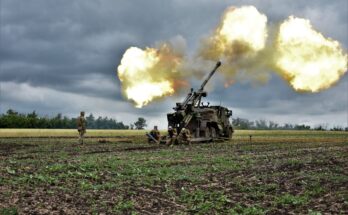
A snapshot of recent news from sources around the world on the ongoing Russia-Ukraine war.
Two Dutch F-35s carried out a first interception from Poland on Monday, February 13 The Dutch F-35s escorted two Su-27s and an Il-20 flying out of Kaliningrad as they approached the Polish NATO area.
Almost a year into the conflict and Russia has lost “strategically, operationally and tactically” in its war in Ukraine, said U.S. Chairman of the Joint Chiefs of Staff General Mark A. Milley.
NATO Secretary General Jens Stoltenberg said that a year on, support to Ukraine from nations around the world matters more than ever. There are no signs Russia is preparing for peace. “What we see is the opposite, he is preparing for more war, for new offensives and new attacks. So, it makes it even more important that NATO allies and partners provide more support to Ukraine.”
More aid is on the way, including an equipment package comprising drones, ammunition, air defense, and electronic warfare systems valued at GBP200 million ($243 million). The aid is from the first package from the International Fund for Ukraine (IFU), which includes Denmark, the Netherlands, Norway, Sweden, and the U.K. These partners, along with Iceland and Lithuania, have contributed a collective total of more than GBP520 million ($633 million) to the fund.
Two Russian brigades have suffered heavy losses in the battle for the Ukrainian city of Vuhledar. Russia’s assault there may be the opening move of an anticipated spring offensive, and the poor performance of Russian forces appears to suggest Moscow continues to struggle on the battlefield. Ukraine estimates Russia has lost at least 130 armored vehicles, including 36 tanks, in fighting around Vuhledar in the past week.
The Ukrainian military says it spotted six Russian balloons over Kyiv, and that one of those balloons was shot down. It is unclear if the balloons were carrying surveillance equipment.
The U.S. Defense Intelligence Agency released a report on the use of lethal Iranian drones in Ukraine. The report covers the Shahed-136 one-way attack unmanned aerial vehicle, renamed Geran-2 by the Russians; the Shahed-131 one-way attack UAV, renamed Geran-1 by the Russians; and the Mohajer-6 multirole UAV.
The U.S. says it wants to train Ukrainian forces to move around the battlefield more effectively and rely less on heavy artillery barrages. Both sides of the conflict have expended thousands of artillery rounds, and concern is growing about the continued supply of ammunition.
U.S. officials say 11 countries have committed to sending tanks to Ukraine. The list includes a growing number of countries working on providing Leopard 2 tanks, including Canada, Denmark, Germany, the Netherlands, Norway, Poland, Portugal, and Spain. Further, a total of 22 countries have promised to provide infantry fighting vehicles, and 16 countries are sending artillery and other munitions.
Ukrainian soldiers are currently being trained on four combat-ready Leopard 2 tanks from Canada. Ottawa sent the tanks to Poland, where 25 Canadian instructors are working with Ukrainian forces to familiarize them with the platform.
Russian forces fired more than 100 missiles at Ukraine’s infrastructure and other facilities on February 10. Ukrainian officials said around 61 of these missiles were shot down by its air defense forces.
Moscow continues to pound targets through Ukraine with missiles and attack drones as its ground forces try to seize Bakhmut. Russia launched 32 missiles in the early hours of February 16.
The Ukrainian military may receive more surface-to-air missiles (SAMs) from its Western allies. NATO is reportedly preparing to step up missile deliveries to counter a new Russian large-scale aerial assault as part of a spring offensive.
Demand for U.S.-made weapons is surging in Europe in the wake of Russia’s invasion of Ukraine. However, demand is focused on less expensive, less-sophisticated systems such as shoulder-fired missiles, artillery, and UAVs rather than on big-ticket items like fighter jets and tanks.
For 50 years, Forecast International intelligence reports have been the aerospace and defense industry standard for accurate research, analysis, and projections. Our experienced analysts compile, evaluate, and present accurate data for decision makers. FI's market research reports offer concise analysis of individual programs and identify market opportunities. Each report includes a program overview, detailed statistics, recent developments and a competitive analysis, culminating in production forecasts spanning 10 or 15 years. Let our market intelligence reports be a key part of reducing uncertainties and mastering your specific market and its growth potential. Find out more at www.forecastinternational.com



